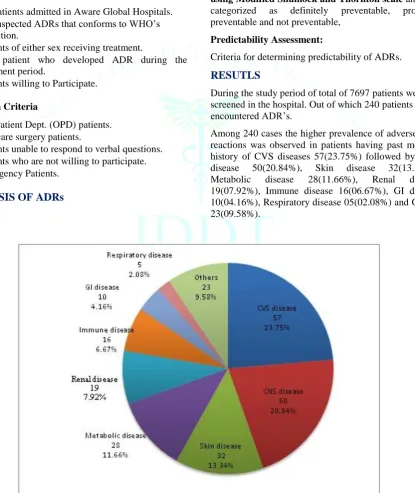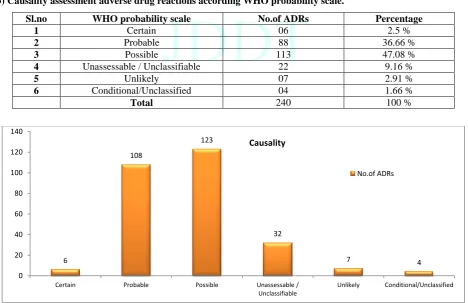Available online on 15.09.2018 at http://jddtonline.info
Journal of Drug Delivery and Therapeutics
Open Access to Pharmaceutical and Medical Research© 2011-18, publisher and licensee JDDT, This is an Open Access article which permits unrestricted non-commercial use, provided the original work is properly cited
Open
Access
Case Report
ANALYSIS OF PATIENT ADMISSIONS IN HOSPITAL DUE TO
ADVERSE DRUG REACTION
Mr. Shivkumar Kashinath Shete*
1, Dr. K. Sattanathan
21
Research scholar Mewar University Rajasthan, India
2
Research Supervisor Mewar University Rajasthan, India
ABSTRACT
The present study is prospective and observational non-interventional study was conducted in tertiary care center. All suspected ADRs which are observed in hospital stay will be assessed for causality, severity, preventability and predictability. The results were presented as number and percentage. Among the 7697 cases ( both males and females), a total of 240 ADRs were detected, an overall incidence of 03.11 % adverse drug reactions in inpatients. The high prevalence of ADR mostly observed in the age group between 1-10 years 48 (20.00%) From this 240 ADR’s where 7.96% on continuing t, 38.36% are recovering, 47.08% are recovered.
Keywords: Adverse drug reaction, Causality, Severity, Preventability, Probability.
Article Info:
Received 18 July, 2018; Review Completed 16 Aug 2018; Accepted 1 9 Aug 2018; Available online 15 Sep 2018Cite this article as:
Shete SK, Sattanathan K, Analysis of patient admissions in hospital due to adverse drug reaction, Journal of Drug Delivery and Therapeutics. 2018; 8(5):5-9 DOI:http://dx.doi.org/10.22270/jddt.v8i5.1866
*Address for Correspondence:
Dr. Shivkumar Shete, Research scholar Mewar University Rajasthan & Assistant Professor, Sree Dattha Institute of Pharmacy, Hyderabad, India. 501510
INTRODUCTION
The WHO defines an “Adverse drug reactions “any response to a drug which is noxious and unintended and which occurs or doses normally used in man of prophylaxis diagnosis or therapy of disease or for the modification of physiologic function”.1
Pharmacovigilance has been defined by the WHO as ‘the science and activities relating to the “detection, assessment, understanding and prevention of adverse effects or any other drug-related problems”.2
Adverse drug reactions (ADRs) are types of adverse drug events (ADEs). ADEs include ADRs, medication errors and other drug-related problems. ADEs are the negative consequences of drug misadventures. Henri Manasse defined drug misadventure as the iatrogenic hazard that is an inherent risk when drug therapy is indicated.
The American Society of Health- System Pharmacists (ASHP) defines significant ADRs as any unexpected, unintended, undesired, or excessive response to a drug that includes the following.3,4,5
Requires discontinuing the drug
Requires changing the drug therapy
Requires modifying the dose
Necessitates admission to the hospital
Prolongs stay in a health care facility
Necessitates supportive treatment
Significantly complicates diagnosis
Negatively affects prognosis or results in temporary or permanent harm, disability or death.
METHODOLOGY
Study Location
Study Design
Prospective, Observational and Non- interventional.
Study Period
Study period for data collection was carried out for 3years (March 2015 To March 2018 )
Study Setting
Study includes only those patients who experience an adverse reaction to medicine used either during their stay in hospital (IPD) or visiting the outpatient departments (OPD).
Patients Selection:
Study participants were inpatients in general medicine department according to the inclusion and exclusion criteria.
Inclusion Criteria
All patients admitted in Aware Global Hospitals.
All suspected ADRs that conforms to WHO’s definition.
Patients of either sex receiving treatment.
Any patient who developed ADR during the treatment period.
Patients willing to Participate.
Exclusion Criteria
Out Patient Dept. (OPD) patients.
Day care surgery patients.
Patients unable to respond to verbal questions.
Patients who are not willing to participate.
Emergency Patients.
ANALYSIS OF ADRs
Types of adverse drug reactions based on Rawlins
and Thompson classification:
In this classification, the ADRs are categorized into two classes viz type A and type B reactions.
Causality Assessment:7
Different scales for assessing causality relationship between suspected drug and reaction was established by using World Health Organization (WHO) Causality Assessment Scale .
Severity Assessment:
The severity of reported reactions was assessed by using Hartwig & Seigel scale which are categorized into mild, moderate and severe
Preventability Assessment:
The preventability of reported ADRs was assessed by using Modified Shumock and Thornton scale and was categorized as definitely preventable, probably preventable and not preventable,
Predictability Assessment:
Criteria for determining predictability of ADRs.
RESUTLS
During the study period of total of 7697 patients were screened in the hospital. Out of which 240 patients encountered ADR’s.
Among 240 cases the higher prevalence of adverse drug reactions was observed in patients having past medical history of CVS diseases 57(23.75%) followed by CNS disease 50(20.84%), Skin disease 32(13.34%), Metabolic disease 28(11.66%), Renal disease 19(07.92%), Immune disease 16(06.67%), GI disease 10(04.16%), Respiratory disease 05(02.08%) and Others 23(09.58%).
2 ) ADRs were distributed according to the WHO ART system codes
It includes different systems and number of ADR’S found in each system: most of ADRs were experienced by Gastrointestinal 72 (25.71%) reactions followed by Dermatology 31 (21.78%) reactions, Central nervous
32 (11.42%) reactions, Endocrine 27 (09.64%) reactions, Hepatic system and Haematology17(06.07%) reactions, Cardiovascular 12 (04.28%), Otic system 10(03.57), Renal System 09 (03.21%), Muscular skeletal 7(02.50%) ,Ophthalmic 03(01.07%) and General disorders-13(04.64%).
Figure 2: ADRs were distributed according to the WHO ART system codes
3) Causality assessment adverse drug reactions according WHO probability scale.
Sl.no WHO probability scale No.of ADRs Percentage
1 Certain 06 2.5 %
2 Probable 88 36.66 %
3 Possible 113 47.08 %
4 Unassessable / Unclassifiable 22 9.16 %
5 Unlikely 07 2.91 %
6 Conditional/Unclassified 04 1.66 %
Total 240 100 %
Figure 3: Causality assessment adverse drug reactions according WHO probability scale. 61
7
32
3 10
72
17
27
12
17
9
13 21.78
2.5 11.42 1.07 3.57
25.71
6.07 9.64 4.28 6.07 3.21 4.64
0 10 20 30 40 50 60 70 80
No. Of ADRs
Percentage
6
108
123
32
7 4
0 20 40 60 80 100 120 140
Certain Probable Possible Unassessable /
Unclassifiable
Unlikely Conditional/Unclassified
Causality
4 ) Assessment of severity of adverse drug reactions according Modified Hartwig and Siegel scales
The 240 ADRs severity was assessed, most of the patients are at level-4A 94 (39.16%) followed by
lavel-4B 79 (32.91%), at level-5 17 (07.03%) of patients, 25 (10.41%) patients at level-3 and 06 patients severity at mild 7 (02.91%) and 6 (2.5%) patients are at level-1 and level-2 respectively. 2 (00.71%) patients have permanent harm at level-6.
Figure 4: Assessment of severity of adverse drug reactions according Modified Hartwig and Siegel scales.
5 ) Assessment adverse drug reactions Predictability
S. No Preventability No. of ADRs Percentage
1 Definitely Preventable 142 59.16 %
2 Probably Preventable 87 36.25 %
3 Not Preventable 11 4.58 %
* Total 240 100 %
Figure 5: Assessment adverse drug reactions Preventability
CONCLUSION
Among age groups adults were predominant over children andgeriatric in terms of prevalence, while males have higher risk to develop ADRs among children and adults and in geriatrics both the genders have high risk in developing ADRs. Among the 240 cases documented 60.83% were male and 39.17% were female, showing 1.55 times higher risk for males to develop ADRs and shown 1.105 times higher risk for ADRs in individuals of urban area compared to rural area. Among all the individuals regardless of sex the distribution of ADRs is significant over rural areas. Among 240 cases the higher prevalence of adverse drug reaction was observed in
patients having past medical history of CVS diseases and CNS disease. And most of ADRs were experienced by Gastrointestinal and Dermatology. The risk factors which are highly involved among ADRs are Self-medication with non-prescribed Self-medications followed by Inappropriate Lack of knowledge (About ADRs)Poly Pharmacy or Multiple Drug Therapy Wrong time and administration, Age, Hypersensitivity and drug with narrow therapeutic index. Most of ADRs were identified by Doctors or Prescribers.
ADR reporting and monitoring in a multi super specialty tertiary care hospital must be continuous and ongoing process and it should be record for both old and newly marketed drugs and medicinal products. This will provide baseline data regarding the safety and efficacy of various drugs which are continuously and rarely used drugs.
Serious ADRs responsible for prolonged hospitalization enhance morbidity and also cause economic burden on patient and hospital. So ADR monitoring is considered very important task in hospital, as it justifies the benefit versus risk ratio of drugs to direct patient.
Hence, it can be concluded from the present study that high level implementation of ADR monitoring and reporting should be done so as to provide optimum and safe patient care for obtain required therapeutic outcome.
7 6
25
94
79
17
2 0
20 40 60 80 100
Level 1 Level 2 Level 3 Level 4 A Level 4 B Level 5 Level 6
Severity Scale
Frequency
142 87
11
Preventability Scale
REFERENCES
1. Patrick W et al. An introduction to Pharmacovigilance,
Blackwell; 6, 2017, 2.
2. Parthasarathi G et al. A Text book of clinical Pharmacy
Practice Essential concepts and skills. 2004, 84100.
3. Tipnis HP, Bajaj A. Textbook of Clinical Pharmacy, 2009,
75-105.
4. Sethi R et al. Elements of Pharmacovigilance, Page.no.
109-123.
5. Mohamed M.M. et al. Knowledge and awareness of adverse
drug reactions and pharmacovigilance practices among healthcare professionals, Pub Med; 2015; 23(2):154-161.
6. Aronson J, Ferner R. Joining the DoTS: new approach to
classifying adverse drug reactions. BMJ; 2003; 327(7425):1222–1225.
7. Edwards R. Causality Assessment in Pharmacovigilance: Still
a Challenge. Drug Saf; 2017.
8. Lukshmy M Hettihewa et al. Casualty Assessment and The
Severity Of The Adverse Drug Reactions (Adr) Actively Detected In Hospital-In Patients In Tertiary Care Hospital Sri Lanka: Prospective Observational Survey, Asian Journal of Research in Biological and Pharmaceutical Sciences. 2014; 2(1):1-10.
9. Classen DC et al.Adverse drug events in hospitalized patients.
Excess length of stay, extra costs, and attributable mortality, JAMA; 1997; 277(4):301-6.
10. Schumock GT, Thornton JP. Focusing on the preventability of
adverse drug reactions. Hosp Pharm. 1992; 27(6):538.
11. Elbe D, Savage R. How does this happen? Part 1: mechanisms
of adverse drug reactions associated with psychotropic medications. J Can Aca Child Adol Psychiat 2010; 19:40-45.
12. Acheampong F, et al. Drug related problems and their clinical
interventions in a ghanan teaching. Safety in Health. 2016; 2:15.
13. Adusumilli PK, Adepu R. Drug related problems: An
overview of various classification systems. Asian J Pharm Clin Res. 2014; 7(4):8-10.
14. Basharat S, Asmat S, Dr. Zaka M. Management of drug
related hospital admissions. 2016; 6(11):2250-3153.
15. Beijer HJM and Blaey CJD. Hospitalisations caused by


